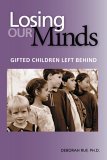![]() Gifted
Assessment and I.Q Testing
Gifted
Assessment and I.Q Testing
I.Q.
testing is a component of Gifted Assessment. This page provides information
that you might use if your student participates in I.Q Testing.
Is
I.Q. (Intelligence Quotient) Important?
The concept of IQ, or "Intelligence Quotient" was first introduced
by French psychologist Alfred Binet in 1904. IQ Testing is a method
used by psychologists to measure what is generally considered intelligence.
I.Q. Testing is only one part of gifted identification. People will
debate the pro's and con's of IQ testing. Rather than go into this debate,
we'll provide you with some information to help make your own decision
about IQ testing.
Apparently, neither of the current tests adequately measure abilities of children whose true IQ is above 130. A child from a background offering limited exposure to situations examined in these tests may not do as well. Results of intelligence tests are usually reported in a single standard score, an Intelligence Quotient or IQ. The
schools may choose to use other kinds of tests in their screening
processes for admission to Talented and Gifted (TAG) programs.
Schools most likely will choose tests that will identify students
that meet their specific program goals and budgets. . Books: "Intelligent Testing with the WISC-III (Wiley Series on Personality Processes)" by Alan S. Kaufman. "Upside-Down Brilliance: The Visual Spatial Learner" by Linda Kreger Silverman
The Wechsler Intelligence Scale for Children WISC is a battery of tests for 6 to 17 year olds that evaluates intellectual abilities. The WISC consists of two scales, the Verbal Scale and the Performance Scale. Each of these scales has several subtests.These sub-test scores are scaled from 1 - 19, with 10 being an average score. The Verbal Scale measures language expression, comprehension, listening, and the ability to apply these skills to solving problems. The examiner gives the questions orally, and the child gives a spoken response. The Performance Scale assesses nonverbal problem solving, perceptual organization, speed, and visual-motor proficiency. Included are tasks like puzzles, analysis of pictures, imitating designs with blocks, and copying. It is important to review the sub-test scores; they can identify strengths and weaknesses of the child. One or two unusually low sub-test scores may indicate a potential learning disability, which could lower a child's overall IQ score and make a gifted child look "average". Relatively low scores mixed with higher scores could make a gifted child look 'non-gifted' when in fact he could be "twice exceptional". [See our pages on "twice exceptional"] Ceiling effects, or high scores on sub-tests may also be particularly misleading in cases where the child has widely varying abilities. If the student has two or more sub-test scores in the ceiling range (17 - 19) indicating that the child reached the ceiling of the test, he might be re-tested using a test designed to differentiate highly gifted children. If your student "maxes-out" one or more subtests you can safely assume that your student is probably "gifted" if not highly gifted in that area. Having the Stanford Binet administered at that point is probably a good idea if you really want to know if your student is highly gifted. Recognizing that your student is gifted in one of the subtests may also help you determine a dominant learning style. [See our pages on "learning styles"] Intelligence tests are samples of problem solving abilities and learned facts, and are good predictors of future learning and academic success. However, there are several factors that the tests do not measure. For instance, they cannot determine motivation, curiosity, creative talent, work habits, study skills, or achievement in academic subjects. These should also be considered when interpreting the scores in this report. Several
scores are obtained from the WISC. Scale scores (Verbal and Performance
IQ scores) are the summary measures of verbal and performance
skills, and the Full Scale IQ is an index of general intellectual
functioning.
Scores
on the WISC of 135 or above may be artificially low since the
test itself has a maximum of 150.
A Percentile rank expresses the relative position of a score. For example, a percentile rank of 98 means that a child has scored as well as or better than 98% of students of the same age on that subtest. The confidence interval indicates the probable range of scores which can be expected when this individual is retested. Subtest scaled scores (listed below) range from 1 to 19.
|
|
©
2005-2022. Bright Kids at Home LLC. All
Rights Reserved.
|







